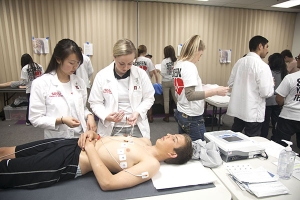Are your child's bones healthy?
 There are 206 bones in the human body, and the skeleton comprises 20 percent of total body weight. For bones to become strong, it’s critical that your child meets her daily-required calcium needs every day. Eating plenty of calcium-rich dairy foods such as milk, cheese and yogurt during childhood and adolescence will help build strong bones and reduce the risk of fractures and osteoporosis later in life, according to a report released today by the American Academy of Pediatrics (AAP). Sadly most studies show that many children fail to meet the required nutrients for strong bones, more than 86 percent of girls and 65 percent of boys fail to get enough calcium after age 11.
There are 206 bones in the human body, and the skeleton comprises 20 percent of total body weight. For bones to become strong, it’s critical that your child meets her daily-required calcium needs every day. Eating plenty of calcium-rich dairy foods such as milk, cheese and yogurt during childhood and adolescence will help build strong bones and reduce the risk of fractures and osteoporosis later in life, according to a report released today by the American Academy of Pediatrics (AAP). Sadly most studies show that many children fail to meet the required nutrients for strong bones, more than 86 percent of girls and 65 percent of boys fail to get enough calcium after age 11.
| Age (years) |
Daily Calcium Needs |
| 1 to 3 |
500 |
| 4 to 8 | 800 |
| 9 to 18 |
1,300 |
| 19 to 50 |
1,000 |
Calcium, the key for strong bones
Calcium is the most abundant mineral in the human body and 99 percent of it is found in our bones and teeth. Adequate calcium intake during the growing years is essential to achieve optimal peak bone mass. The preteen and teenage years are critical for bone development because the majority of bone calcium is formed between the ages of 11 and 20. Calcium is best absorbed into bones at around age 12 for girls and age 14 for boys. Relatively little calcium is added to the skeleton after age 20.
Unfortunately, younger children are drinking more juice and less milk, and many children start drinking soda instead of milk at an early age. Teens drink nearly twice as many soft drinks as milk, which significantly reduces the intake of essential nutrients such as calcium, magnesium, riboflavin and vitamin A. More than 70 percent of the calcium in our food supply comes from milk and dairy foods. Without milk on the menu, it’s unlikely your kids will meet their daily calcium needs.
Vitamin D
Vitamin D is often referred to as the “sunshine” vitamin because our bodies create it when our skin is exposed to the sun. About 10 to 15 minutes of sun exposure per day on our face, hands and arms—without sunscreen—is enough to meet our needs. The AAP adjusted their recommendations for vitamin D (issued in 2003) from 200 IU a day beginning in the first two months of life to 400 IU per day.
“Research shows that increasing vitamin D intake can provide lifelong health benefits, yet data indicates that most children are not getting enough,” says Frank R. Greer M.D., FAAP and chairman of the AAP Committee on Nutrition.
Consuming three daily servings of vitamin D-fortified milk provides many other nutrients that contribute to overall health and a reduced risk of chronic diseases. Milk is an ideal source of vitamin D for children due to its unique nutrient-rich package and kid-friendly flavor.
Physical activity and strong bones
Muscle strength and bone strength go together. When muscles work, they pull on the bones, stimulating them to develop and grow denser. Also, when muscles work, hormones are stimulated, which in turn help build stronger bones. As a result, active children have denser bones than sedentary children.
Inactive children and teens who eat inadequate amounts of calcium-rich foods have increased risk of bone fractures. According to “The Journal of the American Dietetic Association,” children who avoided milk were more likely to experience fractures and be overweight than a comparison group of more than 1,000 similarly aged children. The study was the first to link milk avoidance to increased fracture rates.
Activities that are specifically good for bone health include weight-bearing activities such as jogging, walking and dancing or team sports such as soccer or basketball. All of these activities are fun for kids and definitely good for increasing bone health.
|
Tips for Healthy Bones |
| • Be a positive role model by setting a good example. Children will follow your lead if you include calcium-rich food in your diet. |
| • Encourage small changes. Simply choosing a glass of milk instead of a soft drink provides 25% of your teen's daily calcium requirement. |
| • Pack a lunch. Boost calcium by adding a slice of low-fat cheese on a sandwich, or add some cheese sticks for a snack. |
| • Grill or bake salmon once a week for a meal that's rich in vitamin D. |
| • Add tuna fish to a green salad or make tuna sandwiches to help boost vitamin D intake. |
| • Don't be a couch potato. Encourage outdoor family activities such as riding bikes, going for a family hike or spending a day at the beach. |
| • Choose more leafy greens. Dairy isn't the only source for calcium; leafy greens are a good choice for easily absorbed calcium. |
| • Mineral-rich foods such as beans and nuts contribute to overall bone strength. |
| • Supplement your child's diet. Increase calcium by choosing an appropriate calcium supplement formulated for children. |
-----------------------------
Janet Little is a Certified Nutritionist with Henry’s Farmers Market.



















